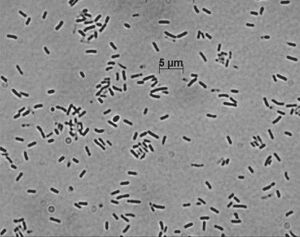Paracoccus pantotrophus: Difference between revisions
No edit summary |
|||
| (9 intermediate revisions by the same user not shown) | |||
| Line 1: | Line 1: | ||
{{Uncurated}} | {{Uncurated}} | ||
[[Image: | [[Image:Paracoccus-pantotrophus.jpg|thumb|300px|right|Legend. Image credit: Name or Publication.]] | ||
==Classification== | ==Classification== | ||
| Line 15: | Line 15: | ||
==Description and Significance== | ==Description and Significance== | ||
Sulfur-oxidizing strains of Paracoccus are often found in deep-sea marine sediments, while other strains can be found abundantly in waste water reservoirsl. Their ability to breakdown nitrogen makes the of particular interest to researchers for their potential as water treatment microbes. | |||
==Genome Structure== | ==Genome Structure== | ||
The genome includes two circular chromosomes, with a total length of about 4.2 billion nucleotides. | The genome includes two circular chromosomes, which encompass 13,000+ genes with a total length of about 4.2 billion nucleotides. | ||
==Cell Structure, Metabolism and Life Cycle== | ==Cell Structure, Metabolism and Life Cycle== | ||
These gram-negative bacteria may be aerobes or facultative anaerobes. They are sulfur-oxidizing chemoautotrophs, and are also well known for their ability to degrade Nitrogen. | |||
==Ecology and Pathogenesis== | ==Ecology and Pathogenesis== | ||
While not pathenogenic, these microbes are still important for humans. Their denitrifying ability is currently being researched for its potential to be utilized for water treatment purposes, such as helping to make wastewater cleaner for reuse. | |||
==References== | ==References== | ||
[https:// | [https://pubmed.ncbi.nlm.nih.gov/31896641/ Bockwoldt JA, Zimmermann M, Tiso T, Blank LM. Complete Genome Sequence and Annotation of the Paracoccus pantotrophus Type Strain DSM 2944. Microbiol Resour Announc;9. Epub ahead of print 2 January 2020. DOI: 10.1128/mra.01290-19.] | ||
Gupta AB. Thiosphaera pantotropha: a sulphur bacterium capable of simultaneous heterotrophic nitrification and aerobic denitrification. | Gupta AB. Thiosphaera pantotropha: a sulphur bacterium capable of simultaneous heterotrophic nitrification and aerobic denitrification. | ||
| Line 39: | Line 36: | ||
[https://www.biorxiv.org/content/10.1101/2023.06.19.545646v1 Hollensteiner J, Schneider D, Poehlein A, Brinkhoff T. Pan-genome analysis of six complete Paracoccus type strain genomes from 2 hybrid next generation sequencing. DOI: 10.1101/2023.06.19.545646.] | [https://www.biorxiv.org/content/10.1101/2023.06.19.545646v1 Hollensteiner J, Schneider D, Poehlein A, Brinkhoff T. Pan-genome analysis of six complete Paracoccus type strain genomes from 2 hybrid next generation sequencing. DOI: 10.1101/2023.06.19.545646.] | ||
[https:// | [https://www.ncbi.nlm.nih.gov/Taxonomy/Browser/wwwtax.cgi?id=82367 Schoch CL, et al. NCBI Taxonomy: a comprehensive update on curation, resources and tools. Database (Oxford). 2020: baaa062. PubMed: 32761142 PMC: PMC7408187.] | ||
Van Aalst-Van Leeuwen MA, Pot MA, Van Loosdrecht MCM, Heijnen JJ. Kinetic modeling of poly(β-hydroxybutyrate) production and consumption by Paracoccus pantotrophus under dynamic substrate supply. Biotechnol Bioeng 1997;55:773–782. | |||
==Author== | ==Author== | ||
Page authored by Jess Shearer, student of Prof. Bradley Tolar at UNC Wilmington. | Page authored by Jess Shearer, student of Prof. Bradley Tolar at UNC Wilmington. | ||
Latest revision as of 01:54, 15 December 2023
Classification
Domain; Bacteria; Pseudomonadota; Alphaproteobacteria; Rhodobacteriales; Paracoccaceae; Paracoccus
Species
|
NCBI: [1] |
Paracoccus pantotrophus
Description and Significance
Sulfur-oxidizing strains of Paracoccus are often found in deep-sea marine sediments, while other strains can be found abundantly in waste water reservoirsl. Their ability to breakdown nitrogen makes the of particular interest to researchers for their potential as water treatment microbes.
Genome Structure
The genome includes two circular chromosomes, which encompass 13,000+ genes with a total length of about 4.2 billion nucleotides.
Cell Structure, Metabolism and Life Cycle
These gram-negative bacteria may be aerobes or facultative anaerobes. They are sulfur-oxidizing chemoautotrophs, and are also well known for their ability to degrade Nitrogen.
Ecology and Pathogenesis
While not pathenogenic, these microbes are still important for humans. Their denitrifying ability is currently being researched for its potential to be utilized for water treatment purposes, such as helping to make wastewater cleaner for reuse.
References
Gupta AB. Thiosphaera pantotropha: a sulphur bacterium capable of simultaneous heterotrophic nitrification and aerobic denitrification.
Van Aalst-Van Leeuwen MA, Pot MA, Van Loosdrecht MCM, Heijnen JJ. Kinetic modeling of poly(β-hydroxybutyrate) production and consumption by Paracoccus pantotrophus under dynamic substrate supply. Biotechnol Bioeng 1997;55:773–782.
Author
Page authored by Jess Shearer, student of Prof. Bradley Tolar at UNC Wilmington.

